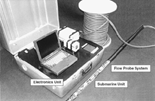

The FlowProbe chemical analyzer can save time and money for organizations that perform chemical monitoring of process streams and hazardous waste sites. The FlowProbe is designed to perform chemical analysis on-site, thus eliminating the need to send samples to an off-site laboratory. "If you can see that a sample has no contaminants right there in the field, you don't have to send it to a lab," said Cecelia V. Williams of Sandia National laboratories' Environmental Restoration Technologies Department. The small sample size used by the FlowProbe also reduces the amount of waste generated during analysis. The project is a joint venture between the Center for Process Analytical Chemistry at the University of Washington, the U.S. Department of Energy's Office of Science and Technology, and Sandia National Laboratories.
 The
FlowProbe chemical analyzer can be operated by one person. The
entire system consists of a sensor, chemical analyzer, a laptop
computer, and ancillary instruments that fit into a container the
size of a large suitcase. The active element of the instrument is
the sensor head, which takes samples from the ground or air being
tested.
The
FlowProbe chemical analyzer can be operated by one person. The
entire system consists of a sensor, chemical analyzer, a laptop
computer, and ancillary instruments that fit into a container the
size of a large suitcase. The active element of the instrument is
the sensor head, which takes samples from the ground or air being
tested.
There are two configurations of the instrument. One design is an above- ground field or process monitoring instrument. The other design is a down-hole unit suitable for two-inch diameter or larger wells. Having two configurations of the probe allows sampling for contaminant plumes in both ground water and the vadose zone. The FlowProbe is currently configured to detect chlorinated hydrocarbons and copper. In the future, other VOCs and iron will be detectable. "An organization could check pipes for the presence of iron, which could mean corrosion," said Williams.
In both designs, the FlowProbe chemical analyzer works using reaction chemistry. Chemicals are diffused across a membrane in the sensor head and into a z-shaped cavity containing a reagent fluid. The reagent fluid mixes with the chemicals being analyzed, reacts, and forms a colored product. Using fiber optic cable, broadband white light is passed through the product, which absorbs light at a characteristic wavelength. The light is then measured by an external spectrometer. A laptop computer uses the resulting light spectrum to determine the concentration of the chemical identified, and tells the operator what amount of the chemical is in the sample.
The FlowProbe was designed to be generic so that many different reagents and membranes could be used within a single probe body, allowing for the detection and analysis of other chemicals. Both configurations can perform up to 500 analyses before the reagent must be replenished, further reducing the cost of the procedure. The FlowProbe currently costs approximately $17,000. Once instruments are in production, the cost could be reduced to less than $10,000.
Three commercial demonstrations were performed with the above-ground probe in 1995 at Dow Chemical in Baton Rouge, Louisiana; Dow Corning in Carrollton, Kentucky; and W.R. Grace in Columbia, Maryland. In 1995, another above-ground demonstration was performed at the U.S. Department of Energy Pinellas facility in Largo, Florida. A down-hole probe demonstration is planned at DOE's Savannah River site in early 1996. The FlowProbe fact sheet is available on the World Wide Web at http://www.sandia.gov/eesector/em/fpca.html.
![]()